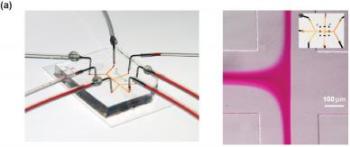Oct 8 2013
Researchers from the University of Illinois at Urbana-Champaign have developed a new approach with applications in materials development for energy capture and storage and for optoelectronic materials.
 This optical micrograph of the microchannel junction with red dye flow-focused in water shows experimental conditions used for nanostructure assembly. Credit: University of Illinois
This optical micrograph of the microchannel junction with red dye flow-focused in water shows experimental conditions used for nanostructure assembly. Credit: University of Illinois
According to Charles Schroeder, an assistant professor in the Department of Chemical and Biomolecular Engineering, the results show that peptide precursor materials can be aligned and oriented during their assembly into polypeptides using tailored flows in microfluidic devices.
The research was a collaboration between the labs of Schroeder and William Wilson, a research professor in materials science and engineering and the Frederick Seitz Materials Research Laboratory at Illinois. Their findings were published in a paper entitled, "Fluidic-directed assembly of aligned oligopeptides with pi-conjugated cores," in the August 2013 issue of Advanced Materials.
"A grand challenge in the field of materials science is the ability to direct the assembly of advanced materials for desired functionality," says Amanda Marciel, a graduate student in Schroeder's lab and one of the paper's authors. "However, design of new materials is often hindered by our inability to control the structural complexity of synthetic polymers.
"To address the need for controlled processing of functional materials, we developed a microfluidic-based platform to drive the assembly of synthetic oligopeptides," Marciel explained. "Using a microfluidic device, we assembled DFAA and DFAG into one dimensional nanostructures using a planar extensional flow generated in a cross-slot geometry."
The dynamics of the assembly process can be followed in real-time using fluorescence microscopy and spectroscopy.
"The assembled nanostructure is spectrally distinct from the synthetic oligopeptide monomer, which can be used to monitor the dynamics of nanostructure formation," Marciel added. "Using precise hydrodynamic control of the microfluidic platform, the researchers demonstrated the formation of multiple parallel-aligned synthetic oligopeptide nanostructures and their subsequent disassembly. By modulating volumetric flow rates in the device they were able to manipulate the position of the fluid-fluid interface at the microchannel junction.
During this process, nanostructures initially formed at the reactive laminar interface are submerged into the advancing acidic stream, thereby preserving the integrity of the preformed nanostructures while initiating formation of an aligned nanostructure at the new interface position.
"Our approach has the potential to enable reproducible and reliable fabrication of advanced materials." Marciel said. "Achieving nanoscale ordering in assembled materials has become the primary focus of recent efforts in the field. These approaches will ultimately lead to desired morphology in functional materials, which will enhance their ability to capture and store energy."
The team's ultimate goal is to assemble the organic equivalent of typical semiconducting materials.
"This would open the door to developments of materials with application to photovoltaic devices, solid-state lighting, energy harvesting, and catalytic processes," she said.
Press release avilable from http://www.eurekalert.org/